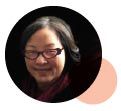
Manager of Connect2culture®
Connect2culture partners with almost twenty cultural organizations in New York City whose education departments and broader missions include building community. In doing so, some have embraced diversity, equity, inclusion, and accessibility (DEIA) to build relationships in the disability communities. In performing and visual arts organizations and in now in some botanic gardens, DEIA offers a framework which they can use to serve visitors with different abilities. These efforts may be through their access programs.

Connect2culture is one of many voices in the larger conversation around arts and disability that presented at this month’s annual Leadership Exchange in Arts and Disability (LEAD) conference in Denver, Colorado. Recognizing that caregivers give so much of themselves, often without realizing the cost to their own health, connect2culture initiated partnerships with NYC cultural organizations to pilot a caregiver program initiative – the Intrepid Sea, Air & Space Museum, Rubin Museum of Art, and Ailey Arts In Education. These institutions created very different pilot programs, meant to offer opportunities for conversations and connections with other caregivers in a non-clinical setting and to refocus attention on their own well-being. The first two programs encourage participants to share reminiscences and make connections with each other and the collection through history and art. The last gives opportunities for caregivers to build stories through dance and movement.
LEAD offered a forum for our panel to present about Caregiver Respite through Creative Engagement. The audience was filled with practitioners and other stakeholders in access programs and services, universal design, law, technology, and training. Our session dug deep into the challenges and successes of these early pilots, asking the session participants to help us think through the process while also suggesting that they consider starting their own similar programs.
Session participants responded positively to the program, with some interested in next steps. How might they support caregivers in their community through local cultural resources? How could they connect with this population? Why embark on this pilot if they already have a program for the caregiver and the person they care for? These are some questions that we addressed in our session which attendees seemed excited to discuss.
In the larger conversation of arts and disability, cultural organizations seek to be more inclusive and sensitive to the intellectual and physical needs and abilities of their visitors by understanding the available, whether technological or human, to make their visit successful. The more voices we have in the room, the more we can ensure that cultural experiences are made accessible and enjoyed by everyone
